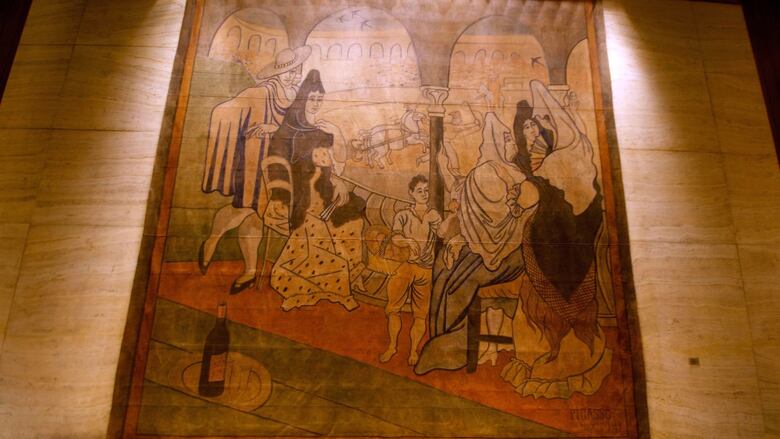Four Seasons restaurant sued over plan to move Picasso painting
Art lovers protest moving of 'Picasso's most readily accessible painting'

New York's storied Four Seasons restaurant has for decades harboured one of the city's more unusual artworks: the largest Pablo Picasso painting in the United States. But a plan to move it has touched off a spat as sharply drawn as the bullfight crowd the canvas depicts.
Pitting a prominent preservation group against an art-loving real estate magnate, the dispute has unleashed an outcry from culture commentators and a lawsuit featuring duelling squads of art experts.
The building's owner says Picasso's "Le Tricorne," a 5.8-by-6.1-metre painted stage curtain, has to be moved from the restaurant to make way for repairs to the wall behind it.
But the Landmarks Conservancy, a nonprofit that owns the curtain, is suing to stop the move. The group says the wall damage isn't dire and taking down the brittle curtain could destroy it — and, with it, an integral aspect of the Four Seasons' landmarked interior.
"We're just trying to do our duty and trying to keep a lovely interior landmark intact," says Peg Breen, president of the conservancy.
Structural necessity
The landlord, RFR Holding Corp., a company co-founded by state Council on the Arts Chairman Aby Rosen, says a structural necessity is being spun into an art crusade.
"This case is not about Picasso," RFR lawyer Andrew Kratenstein said in court papers. Rather, he wrote, it is about whether an art owner can insist that a private landlord hang a work indefinitely, the building's needs be damned. "The answer to that question is plainly no."
Picasso painted the curtain in 1919 as a set piece for "Le Tricorne," or "three-cornered hat," a ballet created by the Paris-based Ballet Russes troupe.
The curtain isn't considered a masterwork. Breen said it was appraised in 2008 at $1.6 million, far short of the record-setting $106.5 million sale of a 1932 Picasso painting at a 2010 auction.
Still, "it was always considered one of the major pieces of Picasso's theatrical decor," says Picasso biographer Sir John Richardson. "And it is sort of a gorgeous image."
The scene depicts spectators in elegant Spanish dress socializing and watching a boy sell pomegranates as horses drag a dead bull from the ring in the background.
"Le Tricorne" has been at the Four Seasons since its 1959 opening in the noted Seagram Building. The restaurant, which isn't affiliated with the Four Seasons hotel a few blocks away, is the epitome of New York power lunching, having served President Bill Clinton, Princess Diana, Madonna and other A-listers.
The curtain hangs in what's become known as "Picasso Alley," a corridor that joins the restaurant's majestically modern, Phillip Johnson-designed main dining rooms.
'Picasso's most readily accessible painting'
Some argue that the painting, donated to the Landmarks Conservancy in 2005, is a vital piece of the city's cultural landscape and the restaurant's lauded decor.
Architecture critic Paul Goldberger decried the curtain's potential move in Vanity Fair, saying the canvas helps make the Four Seasons "a complete work of art."
Noted architect Robert A.M. Stern and Lewis B. Cullman, an honourary trustee of the Museum of Modern Art, both sent Rosen letters asking him to reconsider removing the curtain. Arts critic Terry Teachout blasted the potential loss of "Picasso's most readily accessible painting" in The Wall Street Journal.
The landlords also have their defenders. In tony Town & Country, arts editor Kevin Conley cast the debate as a misplaced outpouring over a "second-rate Picasso."
The debate has opened an uncomfortable divide in the city's preservation circles. The Landmarks Conservancy honored Rosen in 2002 for restoring another important 1950s office building, Lever House, yet now publicly claims the major art collector dismissed the Picasso curtain as a "schmatte," a Yiddish word for "rag."
"They've elevated this into something that it shouldn't be. ... Everybody says I hate Picasso," Rosen lamented to The New York Times last month. "But I live with five of them in my home."
Rosen, whose spokesman didn't return calls from The Associated Press, told The Times he aims to remove and restore the painting, then decide where it will go.
The controversy has drawn a stream of art students, history buffs and other sightseers to look at the canvas.
Breen, for one, isn't surprised.
"Most people would be very happy to have the largest Picasso in America hanging in their building," she said.